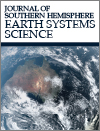Journal of Southern Hemisphere Earth Systems Science
Volume 74
Number 2 2024
Climate evolution and outcomes from the Australian Community Climate and Earth System Simulator (ACCESS) contributions to future scenario experiments are described for the near future (2020–2050), 21st Century (2000–2100) and longer-term (2100–2300). Scenarios range from low-emission, sustainable development to continued fossil-fuel-reliant development. Contrasting climate outcomes between the Northern and Southern Hemispheres are projected in low-emission scenarios that are only apparent on longer timescales, as well as devastating long-term global climate responses to scenarios of continued fossil-fuel use.
A hailstorm simulation over the La Plata Basin in south-eastern South America was evaluated against remote sensing observations. Atmospheric conditions associated with hail fall have been under-explored over the region – in this case-study research, strong 0–8-km bulk shear (60–70 kt, ~30.9–36.0 m s–1) combined with relatively low CAPE values (700–1000 J kg−1) indicates ice cloud formation and hailstorm development. Although this research contributes to understanding hail formation over the La Plata Basin, further research in this direction is needed for consolidation.
The ability of climate models to forecast ocean temperature over weeks to months to seasons underpins various marine applications including fisheries and reef management. Although surface temperatures are often the focus of climate modelling studies, the subsurface can be equally, if not more important, for fisheries and aquaculture stakeholders. Here we take a look at how well the ACCESS-S2 model forecasts ocean temperatures from the surface down to 300 m and show it can be useful for predicting the likelihood of marine heatwaves.
The merging of weather radar data with rain gauge data offers a practically usable and affordable technology to interpolate rainfall amounts at fine spatial resolution between sparsely located rain gauges, particularly in rain-fed agricultural regions. This work details the provision of rainfall maps at high spatial and temporal resolution at the agricultural field scale. Knowledge of the spatial variability of rainfall at the field level can support precision agriculture management strategies for the growing of dryland crops and pastures.
Fog has a big effect on aviation and two case studies are presented to investigate the role of topography on the local circulation and fog formation at Perth Airport. The main finding was that the northerly near-surface winds stem from a blocking of the airmass in the lower levels by the Darling Scarp. The light near-surface winds in combination with nocturnal surface cooling and moisture from the environmental flow create conditions favourable for the development of fog at Perth Airport.
The impacts of tropical cyclone rainfall on the northern coastlines of Australia can be severe. Trends for widespread and localised cyclone rainfall are examined in this paper in three historical datasets using innovative methods. There was a general disagreement in trends and average recurrence interval for the different measures of cyclone rainfall between datasets. By contrast, an increase in the fractional contribution of cyclone rainfall was more consistent between datasets, particularly over the north-western coastal region of Australia.




